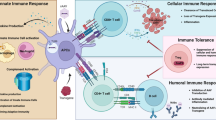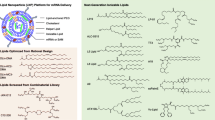Abstract
DNA vaccines are generally weak stimulators of the immune system. Fortunately, their efficacy can be improved using a viral replicon vector or by the addition of immunostimulatory CpG motifs, although the design of these engineered DNA vectors requires optimization. Our results clearly suggest that multiple copies of three types of CpG motifs or combinations of various types of CpG motifs cloned into a viral replicon vector backbone with strong immunostimulatory activities on human PBMC are efficient adjuvants for these DNA vaccines to modulate and enhance protective immunity against anthrax, although modifications with these different CpG forms in vivo elicited inconsistent immune response profiles. Modification with more copies of CpG motifs elicited more potent adjuvant effects leading to the generation of enhanced immunity, which indicated a CpG motif dose-dependent enhancement of antigen-specific immune responses. Notably, the enhanced and/or synchronous adjuvant effects were observed in modification with combinations of two different types of CpG motifs, which provides not only a contribution to the knowledge base on the adjuvant activities of CpG motifs combinations but also implications for the rational design of optimal DNA vaccines with combinations of CpG motifs as “built-in” adjuvants. We describe an efficient strategy to design and optimize DNA vaccines by the addition of combined immunostimulatory CpG motifs in a viral replicon DNA plasmid to produce strong immune responses, which indicates that the CpG-modified viral replicon DNA plasmid may be desirable for use as vector of DNA vaccines.





Similar content being viewed by others
Abbreviations
- PA:
-
Anthrax protective antigen
- PA4:
-
Receptor binding domain of protective antigen
- PBMC:
-
Peripheral blood mononuclear cells
- ODN:
-
Oligodeoxynucleotide
- SFV:
-
Semliki Forest virus
- GMT:
-
Geometric mean titer
- TNA:
-
Toxin-neutralizing antibody
References
Ulmer JB, Wahren B, Liu MA (2006) Gene-based vaccines: recent technical and clinical advances. Trends Mol Med 12:216–222
Liu MA (2011) DNA vaccines: an historical perspective and view to the future. Immunol Rev 239:62–84
Li L, Saade F, Petrovsky N (2012) The future of human DNA vaccines. J Biotechnol 162:171–182
Bins AD, van den Berg JH, Oosterhuis K, Haanen JB (2013) Recent advances towards the clinical application of DNA vaccines. Neth J Med 71:109–117
Abdulhaqq SA, Weiner DB (2008) DNA vaccines: developing new strategies to enhance immune responses. Immunol Res 42:219–232
Saade F, Petrovsky N (2012) Technologies for enhanced efficacy of DNA vaccines. Expert Rev Vaccines 11:189–209
Lundstrom K (2000) Alphavirus vectors: applications for DNA vaccines production and gene expression. Intervirology 43:247–257
Vander Veen RL, Harris DL, Kamrud KI (2012) Alphavirus replicon vaccines. Anim Health Res Rev 13:1–9
Davis HL (2000) CpG motifs for optimization of DNA vaccines. Dev Biol (Basel) 104:165–169
Klinman DM (2003) CpG DNA as a vaccine adjuvant. Expert Rev Vaccines 2:305–315
Leitner WW, Hwang LN, deVeer MJ, Zhou A, Silverman RH, Williams BR, Dubensky TW, Ying H, Restifo NP (2003) Alphavirus-based DNA vaccine breaks immunological tolerance by activating innate antiviral pathways. Nat Med 9:33–39
Ljungberg K, Whitmore AC, Fluet ME, Moran RS, Shabman ML, Collier AA, Kraus AA, Thompson JM, Montefiori DC, Beard C et al (2007) Increased immunogenicity of a DNA-launched Venezuelan equine encephalitis virus-based replicon DNA vaccine. J Virol 81:13412
Näslund TI, Kostic L, Nordström EK, Chen M, Liljeström P (2011) Role of innate signaling pathways in the immunogenicity of alphaviral replicon-based vaccines. Virol J 8:36
Knudsen ML, Mbewe-Mvula A, Rosario M, Johansson DX, Kakoulidou M, Bridgeman A, Reyes-Sandoval A, Nicosia A, Ljungberg K, Hanke T et al (2012) Superior induction of T cell responses to conserved HIV-1 regions by electroporated alphavirus replicon DNA compared to that with conventional plasmid DNA vaccine. J Virol 86:4082–4090
Sato Y, Roman M, Tighe H, Lee D, Corr M, Nguyen MD, Silverman GJ, Lotz M, Carson DA, Raz E (1996) Immunostimulatory DNA sequences necessary for effective intradermal gene immunization. Science 273:352–354
Klinman DM, Yamshchikov G, Ishigatsubo Y (1997) Contribution of CpG motifs to the immunogenicity of DNA vaccines. J Immunol 158:3635–3639
Krieg AM, Wu T, Weeratna R, Efler SM, Love-Homan L, Yang L, Yi AK, Short D, Davis HL (1998) Sequence motifs in adenoviral DNA block immune activation by stimulatory CpG motifs. Proc Natl Acad Sci USA 95:12631–12636
Coban C, Ishii KJ, Gursel M, Klinman DM, Kumar N (2005) Effect of plasmid backbone modification by different human CpG motifs on the immunogenicity of DNA vaccine vectors. J Leukoc Biol 78:647–655
Yu YZ, Li N, Ma Y, Wang S, Yu WY, Sun ZW (2013) Three types of human CpG motifs differentially modulate and augment immunogenicity of non-viral and viral replicon DNA vaccines as built-in adjuvants. Eur J Immunol 43:228–239
Hoene V, Peiser M, Wanner R (2006) Human monocyte-derived dendritic cells express TLR9 and react directly to the CpG-A oligonucleotide D19. J Leukoc Biol 80:1328–1336
Rynkiewicz D, Rathkopf M, Sim I, Waytes AT, Hopkins RJ, Giri L, DeMuria D, Ransom J, Quinn J, Nabors GS, Nielsen CJ (2011) Marked enhancement of the immune response to BioThrax(R) (Anthrax Vaccine Adsorbed) by the TLR9 agonist CPG 7909 in healthy volunteers. Vaccine 29:6313–6320
Marshall JD, Fearon K, Abbate C, Subramanian S, Yee P, Gregorio J, Coffman RL (2003) Van Nest G (2003) Identification of a novel CpG DNA class and motif that optimally stimulate B cell and plasmacytoid dendritic cell functions. J Leukoc Biol 73:781–792
Yu YZ, Zhang SM, Sun ZW, Wang S, Yu WY (2007) Enhanced immune responses using plasmid DNA replicon vaccine encoding the Hc domain of Clostridium botulinum neurotoxin serotype A. Vaccine 25:8843–8850
Yu YZ, Guo JP, An HJ, Zhang SM, Wang S, Yu WY, Sun ZW (2013) Potent tetravalent replicon vaccines against botulinum neurotoxins using DNA-based Semliki Forest virus replicon vectors. Vaccine 31:2427–2432
Ma Y, Yu YZ, Zhu YF, Xu Q, Sun ZW (2013) In vitro and in vivo activities of recombinant anthrax protective antigen co-expressed with thioredoxin in Escherichia coli. Hum Vaccin Immunother 9:242–249
Vollmer J, Weeratna R, Payette P, Jurk M, Schetter C, Laucht M, Wader T, Tluk S, Liu M, Davis HL et al (2004) Characterization of three CpG oligodeoxynucleotide classes with distinct immunostimulatory activities. Eur J Immunol 34:251–262
Liu Y, Luo X, Yang C, Yu S, Xu H (2011) Three CpG oligodeoxynucleotide classes differentially enhance antigen-specific humoral and cellular immune responses in mice. Vaccine 29:5778–5784
Chen YS, Hsiao YS, Lin HH, Liu Y, Chen YL (2006) CpG-modified plasmid DNA encoding flagellin improves immunogenicity and provides protection against Burkholderia pseudomallei infection in BALB/c mice. Infect Immun 74:1699–1705
Kojima Y, Xin KQ, Ooki T, Hamajima K, Oikawa T, Shinoda K, Ozaki T, Hoshino Y, Jounai N, Nakazawa M et al (2002) Adjuvant effect of multi-CpG motifs on an HIV-1 DNA vaccine. Vaccine 20:2857–2865
Pontarollo RA, Babiuk LA, Hecker R, Van Drunen Littel-Van Den Hurk S (2002) Augmentation of cellular immune responses to bovine herpesvirus-1 glycoprotein D by vaccination with CpG-enhanced plasmid vectors. J Gen Virol 83:2973–2981
Schneeberger A, Wagner C, Zemann A, Luhrs P, Kutil R, Goos M, Stingl G, Wagner SN (2004) CpG motifs are efficient adjuvants for DNA cancer vaccines. J Invest Dermatol 123:371–379
Zhang A, Jin H, Zhang F, Ma Z, Tu Y, Ren Z, Zhang X, Zhu K, Wang B (2005) Effects of multiple copies of CpG on DNA vaccination. DNA Cell Biol 24:292–298
Chen Y, Xiang LX, Shao JZ (2007) Construction of a recombinant plasmid containing multi-copy CpG motifs and its effects on the innate immune responses of aquatic animals. Fish Shellfish Immunol 23:589–600
Martinez-Alonso S, Martinez-Lopez A, Estepa A, Cuesta A, Tafalla C (2011) The introduction of multi-copy CpG motifs into an antiviral DNA vaccine strongly up-regulates its immunogenicity in fish. Vaccine 29:1289–1296
Shoda LK, Kegerreis KA, Suarez CE, Mwangi W, Knowles DP, Brown WC (2001) Immunostimulatory CpG-modified plasmid DNA enhances IL-12, TNF-alpha, and NO production by bovine macrophages. J Leukoc Biol 70:103–112
Acknowledgments
This work was supported by Grants from the National Natural Science Foundation of China (30901375) and Beijing Natural Science Foundation (7102125).
Conflict of interest
The authors declare no financial or commercial conflict of interest.
Author information
Authors and Affiliations
Corresponding authors
Rights and permissions
About this article
Cite this article
Yu, YZ., Ma, Y., Xu, WH. et al. Combinations of various CpG motifs cloned into plasmid backbone modulate and enhance protective immunity of viral replicon DNA anthrax vaccines. Med Microbiol Immunol 204, 481–491 (2015). https://doi.org/10.1007/s00430-014-0359-9
Received:
Accepted:
Published:
Issue Date:
DOI: https://doi.org/10.1007/s00430-014-0359-9




